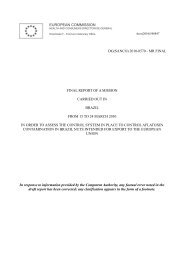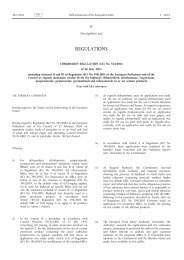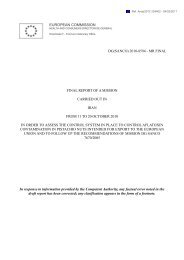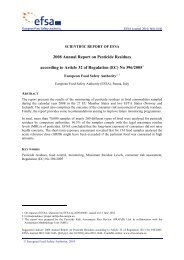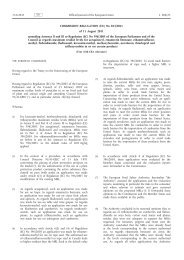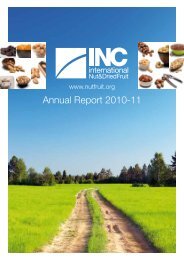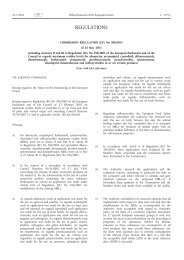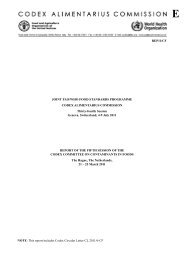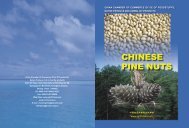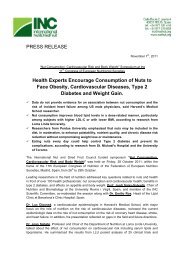Download - International Nut and Dried Fruit Council
Download - International Nut and Dried Fruit Council
Download - International Nut and Dried Fruit Council
Create successful ePaper yourself
Turn your PDF publications into a flip-book with our unique Google optimized e-Paper software.
varieties <strong>and</strong>/or hybrids of these.No comments were submitted on this section <strong>and</strong> EPA adopts thechange as proposed without change.F. Amendment to 40 CFR 180.1(h)The final rule deletes 40 CFR 180.1(h) that reads: ``Unlessotherwise specified, tolerances <strong>and</strong> exemptions established under theregulations in this part apply to residues from only preharvestapplication of the chemical.''One comment was received concerning how a person would know if atolerance is based on pre-harvest or post-harvest use. The commenterasserted that growers need to know what residues they should expectfrom pre-harvest use in order to compare maximum residue limits (MRLs,the international term for residue st<strong>and</strong>ards comparable to toleranceregulations under U.S. law) abroad to know if such commodities may beexported.Given the enforcement concerns articulated in the proposed rule,EPA does not think that the commenter has provided a sufficientrational for maintaining 40 CFR 180.1(h). EPA does not believe that theissue raised by the commenter--the need to determine whether preharvestresidues comport with international MRLs--will often be aproblem. The overwhelming majority of pesticide tolerances are setbased on pre-harvest use of a pesticide. Further, EPA attempts toharmonize tolerances with foreign MRLs, <strong>and</strong> generally, harmonization isnot a problem. Thus, in most cases, comparing the U.S. tolerance levelwith the international MRL will indicate to a grower that pre-harvesttreatment of a commodity will not be inconsistent with internationalMRLs. If a grower comes across an instance where a U.S. tolerance ishigher than a MRL <strong>and</strong> the grower thinks that a higher U.S. tolerance isdue to a post-harvest use, the grower may contact EPA for moreinformation about that particular tolerance. EPA currently collectsvaluable information about tolerances on its Web site. (http://frwebgate.access.gpo.gov/cgi-bin/leaving.cgi?from=leavingFR.html&log=linklog&to=http://www.epa.gov/opp00001/regulating/part-180.html%23info). If information onwhat tolerances are driven by post-harvest uses turns out to becritical information EPA will consider adding that information to itsWeb site.EPA is adopting its proposal without change.G. Other CommentsOne comment was received concerning the new crop group <strong>and</strong> cropsubgroups; the commenter asked whether the residue chemistry guidelineswill be updated or an EPA memor<strong>and</strong>um issued to address the number oftrials <strong>and</strong> locations needed?EPA does not believe that the residue chemistry guidelines need tobe updated at this time or a separate memor<strong>and</strong>um issued to address thenumber of trials <strong>and</strong> locations. EPA plans to update these guidelineswhen more of the crop groups are revised, as this is an ongoing[[Page 76287]]effort. For the present, the current residue chemistry guidelines whichaddress the number of field trials <strong>and</strong> locations should still be usedfor the newly added crop groups <strong>and</strong> crop subgroups.The People's Republic of China suggested that this crop group ruleshould be regarded as a measure under the Agreement on Application ofSanitary <strong>and</strong> Phytosanitary Measures (SPS Agreement) because this cropgrouping regulation has a direct relation on the establishment ofpesticide tolerances. According to the WTO/SPS agreement, the U.S.should submit a notification to WTO. The commenter hoped that the U.S.will fulfill its transparency obligation <strong>and</strong> provide other membersnotice of the measure <strong>and</strong> an opportunity to comment on it.EPA notes that the WTO was notified of the proposed rule as ofMarch 17, 2010, under the SPS Agreement. The notification, WTO DocumentG/SPS/N/USA/1980, included a link to the public docket, where theproposed rule can be found in its entirety.The People's Republic of China inquired as to the next steps afterthis revision, since the proposed revision did not specify thepesticide tolerances for the products. The commenter hoped that theU.S. would provide a timetable for the establishment of MRLs for theproducts in the revision, especially goji berry. Additionally thecommenter asked if EPA would notify the WTO in a timely fashion <strong>and</strong>provide other members with a 60-day comment period when EPA establishesMRLs. Finally, the People's Republic of China indicated that it willcontinue to follow this issue closely <strong>and</strong> hopes to comment on anyfuture tolerances for goji berry.No specific tolerances are established by this rule revising thecrop group. Tolerances for pre-existing crop groups continue in effect<strong>and</strong> do not apply to the revised crop group.As discussed in Unit II.C. of the Proposed Rule (75 FR 807),tolerances established for revised crop groups will include the newcrop group number (<strong>and</strong> new name, if applicable) so that it is apparenton the face of the tolerance regulation what commodities are covered.EPA will initially retain pre-existing crop groups that have been



